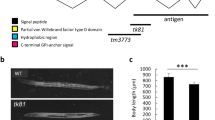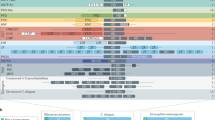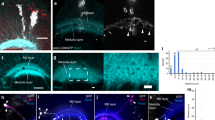Abstract
Down Syndrome cell adhesion molecule (Dscam) genes encode neuronal cell recognition proteins of the immunoglobulin superfamily1,2. In Drosophila, Dscam1 generates 19,008 different ectodomains by alternative splicing of three exon clusters, each encoding half or a complete variable immunoglobulin domain3. Identical isoforms bind to each other, but rarely to isoforms differing at any one of the variable immunoglobulin domains4,5. Binding between isoforms on opposing membranes promotes repulsion6. Isoform diversity provides the molecular basis for neurite self-avoidance6,7,8,9,10,11. Self-avoidance refers to the tendency of branches from the same neuron (self-branches) to selectively avoid one another12. To ensure that repulsion is restricted to self-branches, different neurons express different sets of isoforms in a biased stochastic fashion7,13. Genetic studies demonstrated that Dscam1 diversity has a profound role in wiring the fly brain11. Here we show how many isoforms are required to provide an identification system that prevents non-self branches from inappropriately recognizing each other. Using homologous recombination, we generated mutant animals encoding 12, 24, 576 and 1,152 potential isoforms. Mutant animals with deletions encoding 4,752 and 14,256 isoforms14 were also analysed. Branching phenotypes were assessed in three classes of neurons. Branching patterns improved as the potential number of isoforms increased, and this was independent of the identity of the isoforms. Although branching defects in animals with 1,152 potential isoforms remained substantial, animals with 4,752 isoforms were indistinguishable from wild-type controls. Mathematical modelling studies were consistent with the experimental results that thousands of isoforms are necessary to ensure acquisition of unique Dscam1 identities in many neurons. We conclude that thousands of isoforms are essential to provide neurons with a robust discrimination mechanism to distinguish between self and non-self during self-avoidance.
This is a preview of subscription content, access via your institution
Access options
Subscribe to this journal
Receive 51 print issues and online access
$199.00 per year
only $3.90 per issue
Buy this article
- Purchase on Springer Link
- Instant access to full article PDF
Prices may be subject to local taxes which are calculated during checkout




Similar content being viewed by others
References
Hattori, D., Millard, S. S., Wojtowicz, W. M. & Zipursky, S. L. Dscam-mediated cell recognition regulates neural circuit formation. Annu. Rev. Cell Dev. Biol. 24, 597–620 (2008)
Schmucker, D. & Chen, B. Dscam and DSCAM: complex genes in simple animals, complex animals yet simple genes. Genes Dev. 23, 147–156 (2009)
Schmucker, D. et al. Drosophila Dscam is an axon guidance receptor exhibiting extraordinary molecular diversity. Cell 101, 671–684 (2000)
Wojtowicz, W. M., Flanagan, J. J., Millard, S. S., Zipursky, S. L. & Clemens, J. C. Alternative splicing of Drosophila Dscam generates axon guidance receptors that exhibit isoform-specific homophilic binding. Cell 118, 619–633 (2004)
Wojtowicz, W. M. et al. A vast repertoire of Dscam binding specificities arises from modular interactions of variable Ig domains. Cell 130, 1134–1145 (2007)
Matthews, B. J. et al. Dendrite self-avoidance is controlled by Dscam. Cell 129, 593–604 (2007)
Zhan, X. L. et al. Analysis of Dscam diversity in regulating axon guidance in Drosophila mushroom bodies. Neuron 43, 673–686 (2004)
Zhu, H. et al. Dendritic patterning by Dscam and synaptic partner matching in the Drosophila antennal lobe. Nature Neurosci. 9, 349–355 (2006)
Hughes, M. E. et al. Homophilic Dscam interactions control complex dendrite morphogenesis. Neuron 54, 417–427 (2007)
Soba, P. et al. Drosophila sensory neurons require Dscam for dendritic self-avoidance and proper dendritic field organization. Neuron 54, 403–416 (2007)
Hattori, D. et al. Dscam diversity is essential for neuronal wiring and self-recognition. Nature 449, 223–227 (2007)
Kramer, A. P. & Stent, G. S. Developmental arborization of sensory neurons in the leech Haementeria ghilianii. II. Experimentally induced variations in the branching pattern. J. Neurosci. 5, 768–775 (1985)
Neves, G., Zucker, J., Daly, M. & Chess, A. Stochastic yet biased expression of multiple Dscam splice variants by individual cells. Nature Genet. 36, 240–246 (2004)
Wang, J. et al. Transmembrane/juxtamembrane domain-dependent Dscam distribution and function during mushroom body neuronal morphogenesis. Neuron 43, 663–672 (2004)
Wang, J., Zugates, C. T., Liang, I. H., Lee, C. H. & Lee, T. Drosophila Dscam is required for divergent segregation of sister branches and suppresses ectopic bifurcation of axons. Neuron 33, 559–571 (2002)
Grueber, W. B., Jan, L. Y. & Jan, Y. N. Tiling of the Drosophila epidermis by multidendritic sensory neurons. Development 129, 2867–2878 (2002)
Lee, T., Lee, A. & Luo, L. Development of the Drosophila mushroom bodies: sequential generation of three distinct types of neurons from a neuroblast. Development 126, 4065–4076 (1999)
Chen, B. E. et al. The molecular diversity of Dscam is functionally required for neuronal wiring specificity in Drosophila. . Cell 125, 607–620 (2006)
Brites, D. et al. The Dscam homologue of the crustacean Daphnia is diversified by alternative splicing like in insects. Mol. Biol. Evol. 25, 1429–1439 (2008)
Graveley, B. R. et al. The organization and evolution of the dipteran and hymenopteran Down syndrome cell adhesion molecule (Dscam) genes. RNA 10, 1499–1506 (2004)
Watson, F. L. et al. Extensive diversity of Ig-superfamily proteins in the immune system of insects. Science 309, 1874–1878 (2005)
Grillenzoni, N., van Helden, J., Dambly-Chaudiere, C. & Ghysen, A. The iroquois complex controls the somatotopy of Drosophila notum mechanosensory projections. Development 125, 3563–3569 (1998)
Meijers, R. et al. Structural basis of Dscam isoform specificity. Nature 449, 487–491 (2007)
Sawaya, M. R. et al. A double S shape provides the structural basis for the extraordinary binding specificity of Dscam isoforms. Cell 134, 1007–1018 (2008)
Adams, M. D. et al. The genome sequence of Drosophila melanogaster . Science 287, 2185–2195 (2000)
Kaufman, L. & Rousseeuw, P. J. Finding Groups in Data: an Introduction to Cluster Analysis (Wiley, 1990)
Acknowledgements
We thank T. Lee and B. Dickson for fly stocks, B. Dickson and E. Demir for advice on homologous recombination procedures, S. Miura for staining of embryos, and N. Nocera and other members of the Zipursky laboratory for help in screening homologous recombinants. We thank D. Eisenberg for helpful discussion on mathematical modelling. We thank R. Axel, A. Nern, W. Wojtowicz and other members of the Zipursky and Grueber laboratories for discussion and comments on the manuscript. This work was supported by a grant from the NIH (S.L.Z.), and NRSA from NIH/NINDS (B.J.M.).W.B.G. is a Searle Scholar, McKnight Scholar and Klingenstein Fellow. S.L.Z. is an investigator of the Howard Hughes Medical Institute.
Author Contributions D.H. generated knock-in mutants. B.J.M. and W.B.G. analysed dendritic arborization neuron patterning. D.H. and Y.C. performed analyses of mushroom body and posterior scutellar neurons. L.S. and D.H. conducted mathematical modelling. C.S. performed statistical analysis on the branching of posterior scutellar neuron and linear regression analysis on dendritic arborization neuron data. D.H. and S.L.Z. designed the study and wrote the paper.
Author information
Authors and Affiliations
Corresponding author
Supplementary information
Supplementary Figures
This file contains Supplementary Figures 1-7 with Legends. (PDF 1600 kb)
Rights and permissions
About this article
Cite this article
Hattori, D., Chen, Y., Matthews, B. et al. Robust discrimination between self and non-self neurites requires thousands of Dscam1 isoforms. Nature 461, 644–648 (2009). https://doi.org/10.1038/nature08431
Received:
Accepted:
Issue Date:
DOI: https://doi.org/10.1038/nature08431
This article is cited by
-
The physiology of alternative splicing
Nature Reviews Molecular Cell Biology (2023)
-
The Heterochromatin protein 1 is a regulator in RNA splicing precision deficient in ulcerative colitis
Nature Communications (2022)
-
Cell Communication-mediated Nonself-Recognition and -Intolerance in Representative Species of the Animal Kingdom
Journal of Molecular Evolution (2020)
-
Revisiting Dscam diversity: lessons from clustered protocadherins
Cellular and Molecular Life Sciences (2019)
-
Splicing heterogeneity: separating signal from noise
Genome Biology (2018)
Comments
By submitting a comment you agree to abide by our Terms and Community Guidelines. If you find something abusive or that does not comply with our terms or guidelines please flag it as inappropriate.



